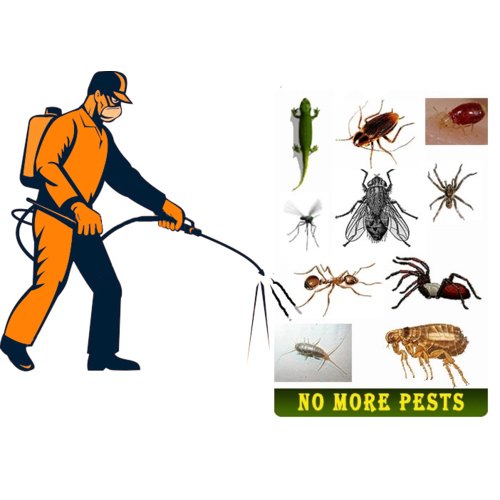Prevent Future Infestations with Services from Pest Control Lockhart
Prevent Future Infestations with Services from Pest Control Lockhart
Blog Article
Discovering Invasion and Therapy Approaches on the planet of Insect Control
The landscape of pest control includes a myriad of challenges, particularly as problems of usual household insects proceed to evolve. Understanding the habits and reproductive patterns of these nuisances is vital for creating effective treatment techniques. By integrating safety nets with advanced administration techniques, such as Integrated Pest Administration (IPM), home owners can better safeguard their settings. The efficiency of these approaches may vary significantly based on specific situations. What hidden factors add to the success or failing of these strategies in different setups?

Common Home Pests
When it pertains to handling our space, understanding common home bugs is vital. These parasites not just interrupt our convenience yet can additionally pose health risks and damage residential or commercial property. The most prevalent household pests include ants, roaches, rats, termites, and bed pests.
Ants, often seen foraging in cooking areas, can pollute food and establish huge nests. Rodents, consisting of mice and rats, can create structural damage and lug diseases like hantavirus and salmonella.
Identifying the indications of these pests, such as droppings, nests, or attack marks, is vital for early treatment (Pest Control Lockhart). Proper hygiene practices, securing entry factors, and preserving a clutter-free setting work preventative measures. By determining these common family pests and recognizing their behaviors, home owners can take proactive actions to mitigate problems, ensuring a much healthier living setting
Comprehending Parasite Infestations
Pest infestations can intensify promptly, turning a small nuisance right into a significant issue if not attended to without delay. Usual variables adding to infestations include poor sanitation, structural vulnerabilities, and seasonal changes that drive pests indoors.
Identifying the sort of pest is important, as different species exhibit varied behaviors and reproductive prices. As an example, rats might establish nests in covert areas while insects like cockroaches grow in wet environments. Early discovery commonly pivots on acknowledging signs such as droppings, gnaw marks, or uncommon noises, which can suggest a problem prior to it ends up being serious.
Cozy, humid climates can promote the rapid development of parasite populations, while adjustments in landscaping or building can accidentally create favorable settings. An informed technique to understanding these dynamics lays the foundation for reliable pest administration approaches in the future.
Treatment Techniques and Methods
Reliable treatment methods and methods are crucial for mitigating insect problems and recovering a safe environment. A diverse technique is usually best, incorporating chemical, biological, and mechanical techniques tailored to the particular insect and the intensity of the problem.
Chemical therapies consist of the usage of pesticides and herbicides, which can effectively eliminate insects. Nevertheless, appropriate application and adherence to security guidelines are vital to decrease threats to human beings and non-target organisms. Integrated Bug Administration (IPM) motivates the sensible use chemicals as a last resource, depending instead on monitoring and limit degrees to figure out treatment requirements.
Biological control approaches website here include introducing all-natural predators or bloodsuckers to minimize insect populaces. This technique is increasingly preferred, especially in agricultural setups, as it promotes environmental sustainability.
Mechanical techniques, such as traps and obstacles, offer prompt relief from pests without presenting chemicals. Options consist of sticky traps for bugs or physical obstacles for rodents.
Ultimately, the option of therapy technique should think about the specific bug, the environment, and prospective impacts on human health and wellness and ecosystems. A well balanced mix of these techniques can properly manage problems while promoting long-lasting parasite control solutions.
Precautionary Measures for House
Proactively resolving pest problems prior to they escalate is crucial for keeping a healthy home atmosphere (Pest Control Lockhart). Applying effective safety nets can dramatically decrease the probability of problems, inevitably safeguarding both your building and well-being

Proper landscaping also plays an essential role in prevention. Keeping hedges and trees cut away from your home lowers the opportunities of bugs discovering their method inside your home. Additionally, guarantee that drainage systems are functioning successfully to avoid standing water, which can attract in mosquitoes and other insects.
Last but not least, regular evaluations are advisable. Regularly looking for indications of insect task enables early intervention. By embracing these preventive steps, homeowners can create an environment that is much less congenial to pests, consequently improving their overall quality of life and minimizing the requirement for considerable pest control treatments.
Commercial Bug Control Approaches
An extensive approach to industrial parasite control is necessary for companies intending to preserve a risk-free and sanitary setting. Reliable approaches include a combination of normal evaluations, staff member training, and the application of Integrated Insect Administration (IPM) practices.
Routine inspections enable early detection Full Article of pest see task, enabling prompt treatment. Services ought to develop a routine timetable for these analyses, concentrating on high-risk areas such as cooking areas, storeroom, and waste disposal websites. Staff member training is just as critical; personnel should be informed on the indicators of pest infestations and the significance of reporting them quickly.
Executing IPM practices assists reduce parasite concerns sustainably. This includes habitat adjustment, such as sealing access points and minimizing clutter, in addition to employing all-natural deterrents prior to turning to chemical treatments.

Moreover, teaming up with a certified insect control service provider makes certain access to professional expertise and innovative treatment options. This partnership can lead to tailored parasite control plans customized to the particular demands of the business, lessening risks and enhancing total effectiveness. Eventually, a positive and enlightened strategy fosters a pest-free setting, safeguarding both public wellness and company credibility.
Conclusion
In final thought, reliable insect control requires a comprehensive understanding of common household insects and their habits, combined with targeted therapy approaches. Applying precautionary actions alongside therapy approaches such as Integrated Pest Monitoring and biological control improves the capacity to reduce invasions.
Report this page